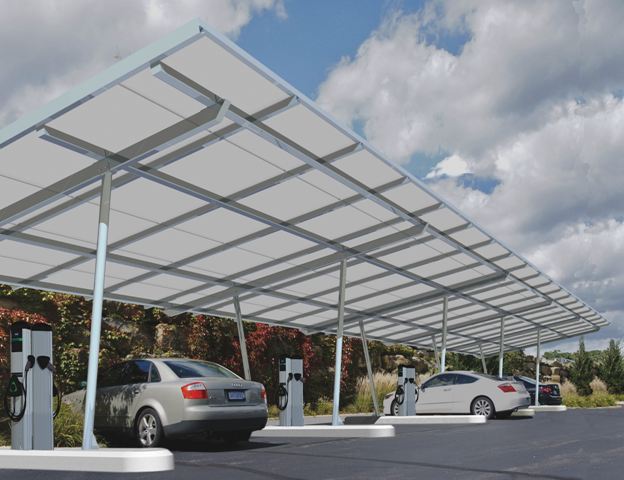Designers no longer need to sacrifice aesthetics to achieve the benefits of building-integrated photovoltaics in canopies and walkways. New solar PV canopy systems from Duo-GardIndustries Inc. are custom-designed and engineered to integrate as part of a building’s architecture.
The canopies are engineered with a sealed skin and continuous components, eliminating any gaps between panels. This achieves a weather-tight structure for all climatic regions. All wiring is built into framing channels for a clean, contemporary appearance.
Available currently in standard sloped and ridge styles, the canopies are configured for the size and scope required for each project. The turnkey approach includes in-house design, engineering, fabrication, and installation services, as well as technical support to specify, plus field support on photovoltaics. A new in-house steel fabrication facility, opened earlier this year, enhance the ability to customize each project.
Aesthetically, the PV panels can be charcoal gray or blue. Designers can also specify integrated translucent multiwall polycarbonate panels to add diffused daylight. The architectural canopy addition follows Duo-Gard’s introduction earlier this year of solar PV charging stations. BD+C
Related Stories
| Aug 11, 2010
'Flexible' building designed to physically respond to the environment
The ecoFLEX project, designed by a team from Shepley Bulfinch, has won a prestigious 2009 Unbuilt Architecture Design Award from the Boston Society of Architects. EcoFLEX features heat-sensitive assemblies composed of a series of bi-material strips. The assemblies’ form modulate with the temperature to create varying levels of shading and wind shielding, flexing when heated to block sunlight and contracting when cooled to allow breezes to pass through the screen.
| Aug 11, 2010
New book provides energy efficiency guidance for hotels
Recommendations on achieving 30% energy savings over minimum code requirements are contained in the newly published Advanced Energy Design Guide for Highway Lodging. The energy savings guidance for design of new hotels provides a first step toward achieving a net-zero-energy building.
| Aug 11, 2010
Perkins+Will master plans Vedanta University teaching hospital in India
Working together with the Anil Agarwal Foundation, Perkins+Will developed the master plan for the Medical Precinct of a new teaching hospital in a remote section of Puri, Orissa, India. The hospital is part of an ambitious plan to develop this rural area into a global center of education and healthcare that would be on par with Harvard, Stanford, and Oxford.
| Aug 11, 2010
Burt Hill, HOK top BD+C's ranking of the nation's 100 largest university design firms
A ranking of the Top 100 University Design Firms based on Building Design+Construction's 2009 Giants 300 survey. For more Giants 300 rankings, visit http://www.BDCnetwork.com/Giants
| Aug 11, 2010
PBK, DLR Group among nation's largest K-12 school design firms, according to BD+C's Giants 300 report
A ranking of the Top 75 K-12 School Design Firms based on Building Design+Construction's 2009 Giants 300 survey. For more Giants 300 rankings, visit http://www.BDCnetwork.com/Giants
| Aug 11, 2010
Turner Building Cost Index dips nearly 4% in second quarter 2009
Turner Construction Company announced that the second quarter 2009 Turner Building Cost Index, which measures nonresidential building construction costs in the U.S., has decreased 3.35% from the first quarter 2009 and is 8.92% lower than its peak in the second quarter of 2008. The Turner Building Cost Index number for second quarter 2009 is 837.







